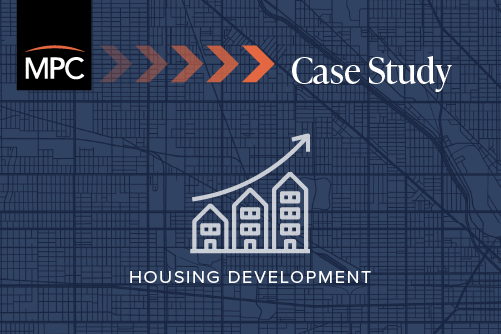Block Build
Habitat for Humanity of Northern Fox Valley, Elgin, Kane County
Housing Development

The development
Habitat for Humanity (HFH) of Northern Fox Valley won the U.S. Housing and Urban Development Secretary’s Award for Excellence in 2006 for its Block Build project in the city of Elgin. With the assistance of Judson College’s Dept. of Architecture and Tinaglia Architects, this development strengthened an existing neighborhood with well-designed homes low-and-moderate income families. Families began occupying the homes in December 2005.
Block Build, located at the corner of Steel and Owasco streets, consists of five single-family, three-bedroom, for-sale homes. The site, purchased from the City, was chosen because it was available at an affordable price and could accommodate construction of multiple homes on the same block. Each lot is roughly 8,700 square feet, and each home is between 1,400 and 1,500 square feet. The homes are targeted to low and moderate-income and first-time buyers, particularly families with children.
The Block Build homes have a historic, bungalow-style design that complements the character of surrounding properties. This was done, in part, through photographic documentation of local homes by architecture students from Judson College. To reduce initial and ongoing costs, the homes are constructed of durable and cost-efficient materials such as vinyl siding and flooring, asphalt shingles and laminate countertops. To keep within the traditional style of homes in the Elgin community, garages are located in the rear of the property and each home has a large front porch. The design caters to families with children by including such features as a clear line of sight from the kitchen to the backyard. One of the homes has a bedroom on the first floor adjacent to a full bathroom to accommodate a disabled family member.
Creating affordability
Reducing construction costs is one method of ensuring affordability. HFH lowered Block Build’s construction costs through a number of methods. It recruited volunteers and sponsors to help with construction of four of the five homes. The HFH model also requires future homeowners to contribute up to 500 hours of their own labor and demonstrate their ability to make required mortgage payments. The fifth home was constructed by the nationally recognized homebuilder Town and Country Homes, which donated materials and labor. Each home had an organizational sponsor such as the Lions Club, which provided funding and construction help. In addition, several financial sponsors, including Bersted Foundation, Centex Homes-Illinois Division, EFS Foundation, Lincoln Financial Group and Motorola, provided funding. The local electrical union volunteered electrical labor for two of the homes, and Conestoga-Rovers & Associates, a Chicago engineering firm, donated design services for the sewer extension for all of the properties. Conestoga-Rovers & Associates also helped HFH with the a U.S. Environmental Protection Agency permit application and oversaw installation of the sewers. Finally, the property owner who sold HFH the land accepted installment payments to make the purchase feasible for the organization.
The homes were initially priced between $116,000 and $140,000. Each was sold to a low-or-moderate income family earning 35 to 60 percent of area median income, which was between $25,340 and $43,440 for a family of four in 2014. Homebuyers are eligible for no-interest financing with 20 to 30-year mortgages from HFH. The mortgage payments amount to no more than 30 percent of the buyer’s annual income. HFH manages the resale prices for the homes through a shared equity program with the buyers. During the first three years of occupancy, if a homeowner sells, HFH purchases the home and the homeowner recovers what he or she paid in principal while occupying the home. If the homeowner sells between the fourth and 13th year, he or she keeps a proportion of the net sales proceeds (10 percent of net proceeds multiplied by years of occupancy). After 13 years, the homeowner can sell the house and keep the total equity of the home.
The Block Build project meets the goals outlined in the City of Elgin’s Comprehensive Plan and Kane County’s 2030 Land Resource Management Plan. Both plans contain strategies to create a range of high-quality housing options at different income levels to meet the needs of a diverse population. Block Build allows low-and-moderate income residents to live near work. By providing options other than market rate housing, the City promoted residential diversity.
Public involvement
Block Build’s success lies in the partnership between the public and private sectors. The architectural design assistance from the Judson College students and overwhelming amount of volunteer labor and fundraising support from individuals and local businesses helped make this project possible.
Habitat for Humanity of Northern Fox Valley has plans to rehab 11 homes in 2014 and 13 homes in 2015, with the objective of building 120 new homes or rehabs between 2011 and 2020. Projects are often scattered across a community. Block Build was an exception because the construction was concentrated in one area, making it easier for people to get involved in the construction and obtain financial support. The development also had a highly visible impact on the street and community. Habitat for Humanity works throughout the region; any community may work with the organization to build more homes for their residents.
Contact
Habitat for Humanity of Northern Fox Valley
847-836-1432, habitatnfv@habitatnfv.org, www.habitatnfv.org
-
Target
Low and moderate-income families.
-
Development information
Type: Single-family ownership
Total Units: 5
Total Affordable: 5
Price Range: $116,000 to $140,000 -
Funding sources
Public and private funding.
-
Success
The project leveraged a partnership between public and private sector groups. The homes are well-maintained and continue to be owned and occupied by their original owners.
-
Lessons learned
Construction concentrated in one area made it easier to involve the public and obtain financial support. It also had a high visual impact on the street and surrounding community. Partnering with a local college can be a way to lower design costs. Eight years after its development, HFH has been able to showcase Block Build to key stakeholders to help increase support for affordable housing.